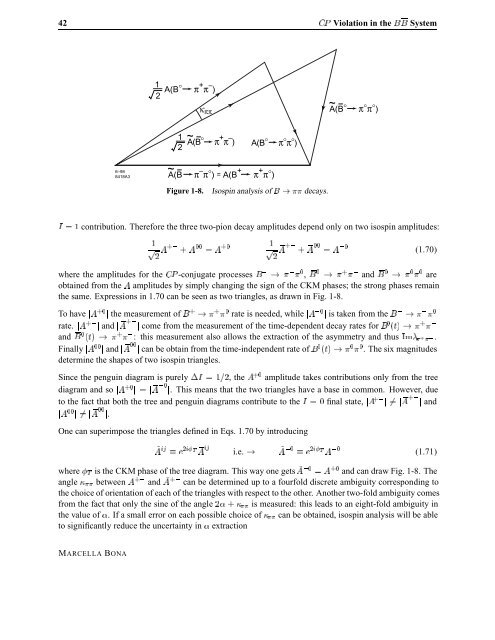Violation in Mixing
Violation in Mixing
Violation in Mixing
You also want an ePaper? Increase the reach of your titles
YUMPU automatically turns print PDFs into web optimized ePapers that Google loves.
42 �È <strong>Violation</strong> <strong>in</strong> the �� System<br />
6–98<br />
8418A3<br />
1<br />
2<br />
A(B° π + π – )<br />
1<br />
2<br />
κππ<br />
A(B° π + π – ~<br />
)<br />
A(B° π°π°)<br />
A(B π – π°) = A(B + π + ~<br />
π°)<br />
Figure 1-8. Isosp<strong>in</strong> analysis of � � �� decays.<br />
~<br />
A(B° π°π°)<br />
Á � contribution. Therefore the three two-pion decay amplitudes depend only on two isosp<strong>in</strong> amplitudes:<br />
Ô �<br />
� � � Ô �<br />
� � �<br />
(1.70)<br />
where the amplitudes for the �È -conjugate processes � � � � , � � � � and � � � � are<br />
obta<strong>in</strong>ed from the � amplitudes by simply chang<strong>in</strong>g the sign of the CKM phases; the strong phases rema<strong>in</strong><br />
the same. Expressions <strong>in</strong> 1.70 can be seen as two triangles, as drawn <strong>in</strong> Fig. 1-8.<br />
To have �� � the measurement of � � � � rate is needed, while �� � is taken from the � � � �<br />
rate. �� � and �� � come from the measurement of the time-dependent decay rates for � Ø � � �<br />
and � Ø � � � : this measurement also allows the extraction of the asymmetry and thus ÁÑ� � � .<br />
F<strong>in</strong>ally �� � and �� � can be obta<strong>in</strong> from the time-<strong>in</strong>dependent rate of � Ø � � � . The six magnitudes<br />
determ<strong>in</strong>e the shapes of two isosp<strong>in</strong> triangles.<br />
S<strong>in</strong>ce the pengu<strong>in</strong> diagram is purely ¡Á � � , the � amplitude takes contributions only from the tree<br />
diagram and so �� � � �� �. This means that the two triangles have a base <strong>in</strong> common. However, due<br />
to the fact that both the tree and pengu<strong>in</strong> diagrams contribute to the Á � f<strong>in</strong>al state, �� ����� �and<br />
�� ������. One can superimpose the triangles def<strong>in</strong>ed <strong>in</strong> Eqs. 1.70 by <strong>in</strong>troduc<strong>in</strong>g<br />
�� �� � � ��Ì � ��<br />
i.e. � � � � � ��Ì �<br />
(1.71)<br />
where �Ì is the CKM phase of the tree diagram. This way one gets � � � � and can draw Fig. 1-8. The<br />
angle ��� between � and � � can be determ<strong>in</strong>ed up to a fourfold discrete ambiguity correspond<strong>in</strong>g to<br />
the choice of orientation of each of the triangles with respect to the other. Another two-fold ambiguity comes<br />
from the fact that only the s<strong>in</strong>e of the angle « ��� is measured: this leads to an eight-fold ambiguity <strong>in</strong><br />
the value of «. If a small error on each possible choice of ��� can be obta<strong>in</strong>ed, isosp<strong>in</strong> analysis will be able<br />
to significantly reduce the uncerta<strong>in</strong>ty <strong>in</strong> « extraction<br />
MARCELLA BONA















